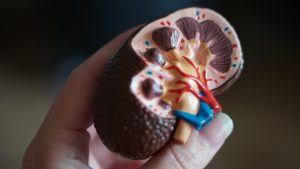 A recent analysis, with some of the longest follow up to date, suggests that patients undergoing endovascular aneurysm repair (EVAR) may experience a significant long term decrease in renal function. The authors, Edmund R Charles and colleagues at the Leicester Vascular Institute for Health Research (NIHR) Leicester Biomedical Centre (Leicester, UK) argue, “This needs to be taken into account when offering EVAR in younger patients,” and suggest that renal follow up and preservation should be optimised in this patient group.
A recent analysis, with some of the longest follow up to date, suggests that patients undergoing endovascular aneurysm repair (EVAR) may experience a significant long term decrease in renal function. The authors, Edmund R Charles and colleagues at the Leicester Vascular Institute for Health Research (NIHR) Leicester Biomedical Centre (Leicester, UK) argue, “This needs to be taken into account when offering EVAR in younger patients,” and suggest that renal follow up and preservation should be optimised in this patient group.
Over the short term EVAR is associated with superior outcomes compared with open repair; however, the progression of renal function after EVAR remains unknown because of the use of inconsistent reporting measures. This study aimed to define long term renal decline following elective EVAR using estimated glomerular filtration rate (eGFR). The investigators note that the present analysis, which appeared in the September 2019 issue of the European Journal of Vascular and Endovascular Surgery, contains the longest reporting of renal outcomes following elective EVAR in the literature to date using precise validated hard renal measures (eGFR).
In the study, patients were followed up over a median of nine years (rang 5–17 years). Their mean eGFR dropped from a preoperative value of 67ml/min/1.73m2 (standard deviation [SD]: 9.4) to 52ml/min/1.732 (SD 7.7), which amounts to a yearly loss of 1.7 units; six patients (2%) required renal replacement therapy (RRT) during late follow up. Patients requiring RRT and those with an eGFR loss exceeding 20% at latest follow up compared with baseline were more likely to die during late follow up (odds ratio 2.4 and 3.3 respectively, p<0.001).
Charles and colleagues detail that the prospectively maintained in house database was used to identify consecutive patients having elective EVAR who had been followed up for more than five years. Overall, 275 patients (23 females, 8%; mean age, 75 years) who were not previously on RRT were included (January 2000–July 2010). Preoperative, postoperative, and most recent eGFR values were evaluated using the chronic kidney disease epidemiology collaboration equation. The primary outcome was change in eGFR at latest follow up.
The investigators note a few limitations of the study. Firstly, although the analysis is based on a prospectively maintained institutional database, it is not a prospective cohort study and outcomes (death and morbidity) were reported retrospectively. Furthermore, comparative analyses were limited, given that an appropriate matches group of patients have open AAA repair and no AAA could not be identified. Finally, a significant number of patients from the original cohort were either lost to follow up or died (36 patients) before completing their five year follow up, hence only 275 patients were included in the final analysis.
Charles and colleagues summarise: “It appears that patients undergoing EVAR exhibit a significant loss of eGFR over the long term and this is associated with poor survival”. They suggest that this conclusion is important for decision making when selecting patients suitable for EVAR, especially younger patients, and also for guiding follow up in this high risk patient group. “Renal function preservation should become part of regular follow up in this setting, especially in male patients with established cardiovascular disease,” they comment.













